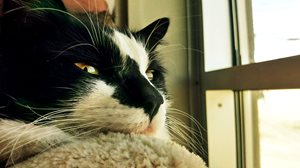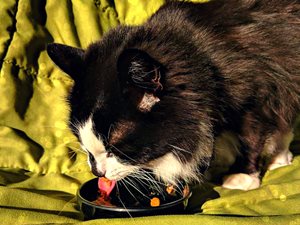Oliver; 4 Paws Veterinary Hospital’s beloved clinic cat has been on a weight loss journey for one year. I know what you may be thinking: why would a pet be on a weight-loss program? Is it some fad diet for pets? Does he go to the gym regularly? Continue reading to follow Oliver on his one-year journey and have many of your diet questions answered (hopefully).

When Oliver came to live with us, he had a small list of medical problems. His two main issues were urinary blockages and obesity. Urinary blockages are caused by a build-up of crystals and stones in the bladder that can cause the urethra to become obstructed. Often, crystals are caused by bad nutrition and an imbalance of pH in urine.
Obesity is also the result of bad nutrition and over-feeding. The solution to both of Oliver’s main health issues was obvious, he needed a diet change!
Not only was this diet change important to help treat his urinary crystals, but obesity can be a major health concern for animals, the exact same as humans.
Animals who are obese have a higher risk of:
- Urinary blockages (male cats)
- Urinary Tract Infections
- Skin disorders
- Orthopedic (bone) diseases
- Cancer
- Endocrine disorders including diabetes and Cushing’s disease
- Respiratory issues
- Kidney dysfunction
- And they also have an overall shorter life expectancy.
Obesity is one of the most common preventable diseases that affect pets. An estimated 60% of cats and 56% of dogs were affected by the disease in 2017 according to a study done by the Association for Pet Obesity Prevention. Indoor cats are at a higher risk than other pets due to lacking environmental needs, lack of exercise and having food available at all times (if not meal fed).
So, how do we combat pet obesity? Finding the right diet to fit yours and your pet’s needs, meal feeding, and exercising are all great places to start. Booking an examination with your veterinarian to discuss your options and to create a weight loss plan can be an effective way to get started on your pet’s weight loss journey.
Now, back to the start of this blog: OLIVER. Oliver weighed 7.03kg on January 2nd, 2018 making him a 4.5/5 on the body condition score scale AKA obese. You cannot judge a pet’s body condition score on the weight number alone, just because Oliver is obese at 7.03kg does not mean every cat at this weight is obese. A healthy Maine Coon cat could easily be a healthy weight at 7.0kg. We judge obesity through the scale weight, overall appearance and through feeling your pet. We look for tucks at the waist, we feel the spine, etc.

Picking a diet for Oliver was a little tricky. He needs to be on a urinary food that helps to eliminate and prevent crystals but also needed food that was low enough in calories that we could feed him a decent volume to ensure he is not hungry.
The best match for Oliver was Royal Canin Multi-Function Urinary S/O + Satiety Support. This food is a combination of urinary health food and a weight loss food. The Urinary S/O side of the food eliminates and dissolves crystals while the Satiety Support side of the food makes Oliver feel full and the food overall is low in calories. We worked with a dietician at Royal Canin to help us pick the food that would best suit him. The Multi-Function food only comes in a dry formula, but Oliver also enjoys eating wet food. Royal Canin let us know that putting him on Satiety Support wet food, along with the dry Multi-Function, would in no way impact his urinary health.
With the help of the veterinarians, technicians and Royal Canin’s Slim Fit Plan we created Oliver’s perfect diet plan. Calculations were done to determine how many calories Oliver would need per day to stay healthy and lose weight. Calorie intake differs from pet-to-pet and every animal needs a different amount to stay healthy.
We began meal feeding Oliver two times a day with a mixture of both canned and dry food. Meal feeding is important, especially for indoor-only cats. It allows us to measure the amount of calories our pet is taking in per day and stops them from eating due to boredom.
Exercise can also help your pet lose weight and having many toys and environmental enrichment can combat boredom, helping stop “boredom eating.” Dogs can be taken outside to exercise but it can be a little trickier to exercise indoor cats. Making sure that cats have plenty of space, interactive toys and spending time playing with them can really help improve their overall health and combat obesity.
Oliver has plenty of environmental stimulation at 4 Paws and gets to play with the staff and clients on a regular basis. This exercise combined with his new meal plan allowed him to get to his goal weight. We’ve all noticed he has far more energy and seems happier overall.
As of January 2nd, 2019, exactly one year after he started his weight-loss journey Oliver now weighs 5.85kg. Weight loss is a slow process, and weight should be lost moderately over a long period of time. In order to stay healthy pets, just like us, should not lose a large amount of weight in a short time. This is why calorie calculations for each pet are important to ensure they are getting the right number of calories and nutrition to be healthy.
After a pet reaches their goal weight it is possible that the vet may want to change up their food or add more calories to their plan in order to maintain their weight and stop them from losing any more. We do not want to go in the opposite direction and make our pets underweight or hungry, many health issues can arise from that as well.
If you would like your pet to lose weight, the safest way to do so is to book an appointment with your veterinarian and create a plan that is specific for your pet. It can be a long process but the benefits to your pet’s health are totally worth it!
Written by: Sara-Dawn Langille, Tech Assistant
Sources:
https://petobesityprevention.org/
https://www.canadianveterinarians.net/documents/obesity-poses-serious-health-hazards-to-pets